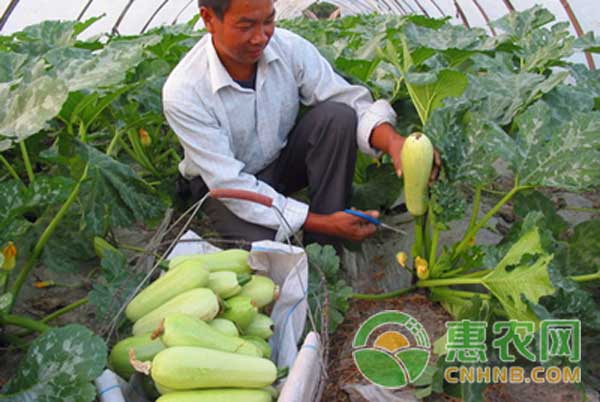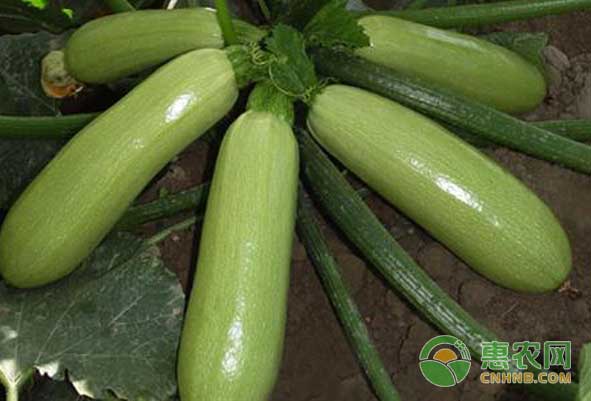Zucchini is one of the most common vegetable varieties cultivated in greenhouse vegetables, and is rich in vitamin C and glucose. The easy cultivation of zucchini is not high on the environment and soil. The economic benefits for the farmers who cultivate the zucchini in greenhouses are considerable. In the western Hunan area, the summer squash was delayed in the greenhouse, and the varieties selected were both high temperature resistant and low temperature resistant.

First, the variety selection
In the early stage of autumn cultivation, it is in the high temperature season, and in the late stage, it enters the cold winter season. It is necessary to select varieties with good comprehensive resistance and high temperature resistance and cold resistance, such as oil beauty and Qingxiu.
Second, cultivate strong seedlings
The best sowing time of zucchini in Xiangxi is late August and early September. The high temperature is not conducive to plant growth, and the harvesting period is shortened too late.
1. Preparation before sowing
Be a seedbed. The shed film around the greenhouse is rolled up and covered with a shade net. Nursery in the greenhouse, the depth of 10 ~ 15 cm wide and 120 ~ 130 cm, the length of the local conditions, but for the convenience of management, the general length of no more than 15 m.
Prepare the substrate and the tray. Each 667 square meters requires a matrix of 0.3 to 0.5 cubic meters, 50 trays (32 holes) and 0.15 cubic meters of river sand.
Prepare the seeds. 1600 seeds are required for every 667 square meters.
2, sowing
1 seed treatment. Before planting, it should be sown for 1~2 days and then tempered with warm water at 55 °C for 20~30 minutes. After soaking, soak it for 1 minute with 1% potassium permanganate solution for 30 minutes.
2 loading trays. Pour the substrate into a pile and spray an appropriate amount of water to stir evenly. It is advisable to use the substrate to grasp the water between the fingers without dripping. After filling the tray with the substrate, the pits of 1.0 to 1.5 cm depth are pressed out.
3 sowing. Place 1 seed in the small pit in each hole of the tray, cover it with the substrate and tidy it out in the nursery, then evenly cover a layer of 1.0~1.5 cm thick river sand, then cover the layer on the tray. Shade the net and spray it in time, spray it to the bottom to see the water.
3, seedling management before the emergence of seedlings every day to check the substrate in the nursery for the rumors because the substrate should be kept moist, if there is water shortage, timely sprinkling water to ensure that the seedlings are neat. When about 70% of the seedlings are broken, the sunshade net on the seedbed should be removed in time, and the 3 leaves and 1 leaf should be planted in front of the heart. The sunshade net on the greenhouse will be removed 2 to 3 days before planting to refine the seedlings.
Third, colonization
1. Preparation before planting
1 button shed, soil preparation, fertilization. The shed was trimmed, and the shed film around the shed was rolled up after the shed. Combined with land preparation and application of 100~200 kg of cake fertilizer, 50 kg of ammonium bicarbonate, 50 kg of superphosphate and 30 kg of potassium sulfate on 667 m2 of land.
2 ridges. It is cultivated with high ridges, with a ridge width of 50 cm, a height of 20 to 25 cm, and a groove width of 50 cm. It is covered with a silver-gray mulch before planting.
2, colonization
When the seedling grows to 2~3 true leaves, it can be planted. One row is planted on the ridge of each ridge, the plant spacing is about 55 cm, and 667 square meters are planted with about 1200 plants. Once again, the root water is planted once and again. Before the weather is planted, a layer of shading net should be placed on the greenhouse to remove the seedlings.
Fourth, post-plant management
1. After the water and fertilizer management is planted, pay attention to the sensation, watering according to the weather conditions, watering every 3~5 days after sitting on the melon and topdressing once every 1-2 days, each time 667 square meters of compound fertilizer 10~15 kg.
2, temperature management, summer squash, greenhouse, late autumn, late cultivation, in the high temperature season, so the shed film around the greenhouse should be rolled up high, so that the apical film can not only shelter from the rain and prevent high temperature baking, when the natural night temperature is lower than 12 At °C, the perimembrane around the greenhouse will be put down, and the ventilation will be adjusted according to the weather conditions. The temperature in the shed during the day is best maintained at 22~25°C and 10~13°C during the night. The temperature during the winter should be increased to 28~30°C, which is beneficial to improve. Ground temperature, maintain night temperature, and achieve the purpose of extending the harvest period.

V. Pest Control
1. Powdery mildew and gray mold are the main diseases of zucchini. Powdery mildew is sprayed with 50% carbendazim wettable powder 500 times solution or 25% triadimefon (triazolone) wettable powder 1000 times solution; gray mold disease with 50% quick kingling (Pythium lycopene) wettable powder 1500 times Liquid or 50% chlorhexidine (isoflumuron) wettable powder 1000 times liquid spray.
2. Aphids and whiteflies are the main pests of zucchini. It can be sprayed with 10% imidacloprid wettable powder 1500 times or 1.8% avermectin EC 2000~3000 times.
Sixth, harvest
According to the growth of melons, melons should be harvested. If the melons are more vigorous, they should be lightly picked. If the melons are weak, they can be properly harvested to adjust the growth of the plants to obtain higher yields.
The above is the main point of late-season cultivation techniques in the greenhouse, but this technology is currently only planted in Hunan Xiangxi, for the reference of farmers in Hunan Xiangxi.
Diagnostic reagents can be divided into two categories: in vivo diagnostic reagents and in vitro diagnostic reagents. It is mostly a reagent for detection by the reaction between antigen and antibody.
A: Classification of in vitro diagnostic reagents:
1. In vitro biodiagnostic reagents managed as drugs include:
1. Blood type and tissue type reagents;
2. Microbial antigen, antibody and nucleic acid detection reagents;
3. Tumor marker reagents;
4. Immunohistochemistry and human tissue cell reagents;
5. Human genetic testing reagents;
6. Biochips;
7. Allergy diagnostic reagents.
2. In vitro reagents managed as medical devices include:
1. Clinical basic test reagents;
2. Clinical chemistry reagents;
3. Blood gas and electrolyte determination reagents;
4. Vitamin determination reagents;
5. Cell histochemical stains;
6. Autoimmune diagnostic reagents;
7. Microbiological test reagents.
B: According to medical test items, clinical diagnostic reagents can be roughly divided into clinical chemical test reagents, immunology and
Serological testing reagents, hematological and cytogenetic testing reagents, microbiological testing reagents, body fluid excretion
Detection reagents, genetic diagnosis reagents, etc. Among them, the market share of clinical chemistry
The largest, close to 34%; followed by the immunology market, accounting for about 29%. Novel immunodiagnostic reagents and genetic diagnostic tests
The reagent was developed in the late 1980s, and it is the most common diagnostic reagent for all current diagnostic reagents, regardless of technology or market.
The fastest growing product.
Urine Rapid Test Kit,Rapid Test Kit 6-Panel,Toxoplasma rapid test kits,Fecal Occult Blood Test
Jilin Sinoscience Technology Co. LTD , https://www.jilinsinoscience.com